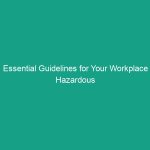Introduction
Good morning team! Today, we’re diving into a crucial topic that affects each of you as essential workers: Essential Worker Rights Guidelines. Understanding your rights is not just about knowing what you are entitled to; it’s about empowering you to protect yourself and your job in the workplace. With the ongoing challenges we face, especially in the current Environment, it’s more important than ever to be informed and proactive about our rights and responsibilities.
Understanding Essential Worker Rights Guidelines
So, what exactly are Essential Worker Rights Guidelines? These guidelines encompass the legal protections and rights afforded to workers deemed essential during crises, such as public health emergencies. They are designed to ensure that you can perform your job safely without compromising your health or well-being.
Understanding your rights is fundamental, not just for compliance, but also for fostering a safe work environment. Many employees are unaware of their rights, leading to misconceptions. For instance, some might think that they cannot refuse unsafe work. However, under various employment laws, you do have the right to refuse work that poses a significant risk to your health.
Key Hazards, Risks, and Safety Considerations
As essential workers, you face unique challenges and Hazards. Here are some key risks associated with your roles:
- Exposure to Health Risks: Working in environments where you may be exposed to contagious diseases.
- Physical Hazards: Engaging in tasks that involve lifting heavy objects or operating machinery.
- Workplace Stress: The pressure to perform under high-stakes conditions can lead to mental health issues.
Ignoring these Safety protocols can have real-world consequences, including workplace accidents, injuries, and even fatalities. It’s crucial to be aware of these risks and take them seriously.
Best Practices, Procedures, & Actionable Advice
Now that we understand the risks, let’s discuss some Best Practices that you can implement immediately to ensure your safety and uphold your rights:
Step-by-Step Safety Procedures
1. **Stay Informed**: Regularly review Workplace Safety policies and guidelines. Ensure you understand your rights regarding safety and health.
2. **Report Unsafe Conditions**: If you notice any unsafe conditions, report them to your supervisor immediately. It is your right to do so without fear of retaliation.
3. **Practice Good Hygiene**: Regular hand-washing and sanitizing workspaces can prevent the spread of illness. Utilize Personal Protective Equipment (PPE) when necessary.
4. **Take Breaks**: Mental and physical fatigue can lead to accidents. Ensure you take regular breaks to recharge.
5. **Communicate**: Engage in open discussions with your team about safety challenges and solutions. Sharing experiences can lead to a safer workplace culture.
Real-Life Examples
Consider the case of a grocery store employee who reported unsafe conditions due to overcrowding during a pandemic. By voicing their concerns, they helped implement crowd Control Measures that protected both staff and customers. This illustrates how understanding and exercising your rights can lead to positive changes.
Regulations, Standards, and Compliance
It’s important to be aware of the Regulations that govern your rights as essential workers. Here are a few key Standards to keep in mind:
- Occupational Safety and Health Administration (OSHA): osha provides guidelines to protect workers from health and safety hazards.
- Americans with Disabilities Act (ADA): Protects workers from discrimination based on disability and ensures reasonable accommodations.
- Family and Medical Leave Act (FMLA): Allows eligible employees to take unpaid leave for specific family and medical reasons without fear of job loss.
Compliance with these regulations is not just a legal obligation; it’s essential for creating a safe working environment. When companies adhere to these standards, they protect not only their workers but also their reputation and productivity.
Employee Engagement & Discussion
Now, I want to hear from you! What safety challenges have you encountered related to your rights as essential workers? Have you ever felt unsure about your rights when faced with unsafe working conditions? Sharing your thoughts could help us all learn and improve our Workplace Safety.
Conclusion & Key Takeaways
In conclusion, understanding your rights as essential workers is vital to protecting yourselves and your jobs. Remember the key points we discussed today:
- Be informed about your rights and Workplace Safety policies.
- Report unsafe conditions and engage in open communication with your team.
- Adhere to safety procedures and regulations to ensure a safe working environment.
Prioritizing safety is not just about compliance; it’s about safeguarding your health and well-being. Thank you all for your attention and commitment to creating a safe workplace. Let’s work together to protect ourselves and each other!


